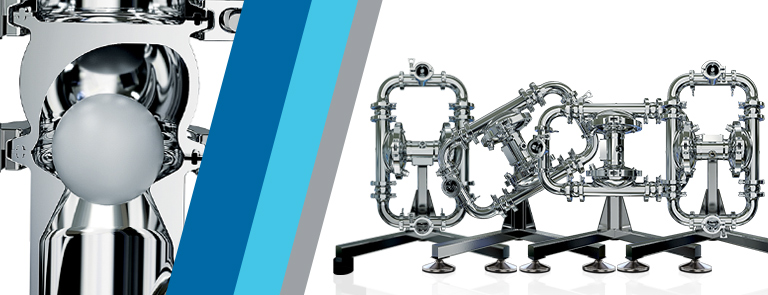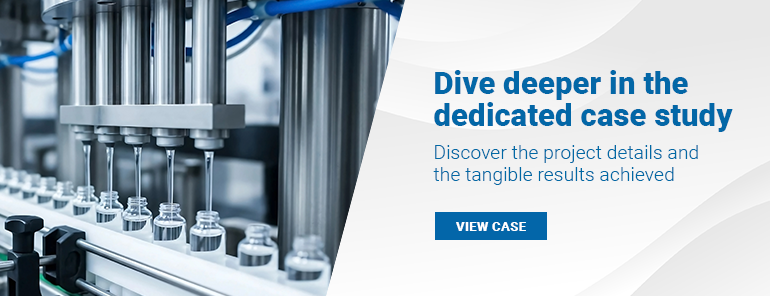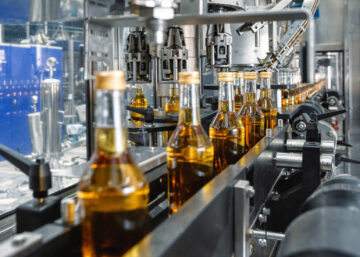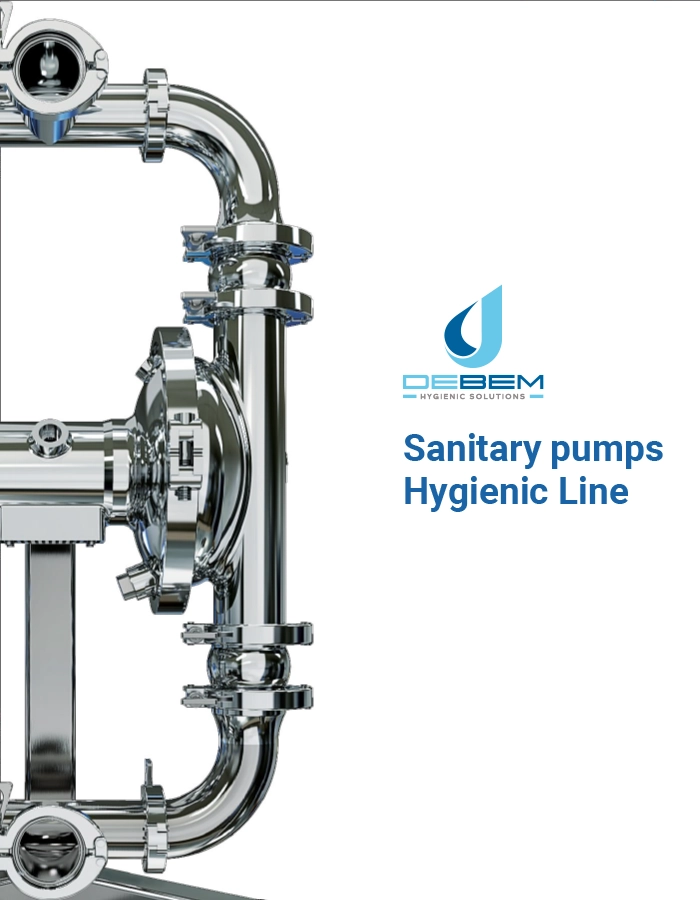Hygienic pumps: a practical guide for the food, beverage, cosmetics and pharmaceutical industries
Hygienic pumps are a strategic component in production processes within the food, beverage, cosmetics and pharmaceutical sectors. The main function of this type of pump is not limited to product transfer but also affects sensory and physical-chemical quality, batch repeatability and the speed of plant sanitation cycles.
To ensure high standards of safety, efficiency and process traceability, hygienic pumps must be equipped with suitable contact materials, low-roughness internal surfaces, sanitary connections and draining geometries.
In production contexts characterised by the transfer of shear-sensitive fluids, frequent changes and stringent hygiene standards, the correct selection of equipment can optimise flow stability, speed up washing and simplify documentary checks. Debem, with its SANI DEBEM line of hygienic pumps, identifies and proposes the most suitable solution for the process, guaranteeing transfer quality, ease of cleaning and production continuity.

What are hygienic pumps?
Hygienic pumps are equipment designed for the transfer of products in regulated environments, with the aim of protecting the quality, repeatability and cleanliness of the plant. Unlike generic solutions, they incorporate features that reduce stagnation, facilitate washing and stabilise the process flow. Before going into design details, it is necessary to identify the elements that make a pump truly “hygienic”. In order to guide the initial assessment, the following aspects must be considered:
- Flow stability: geometries and pumping principles capable of optimising product transfer conditions and reducing unwanted pulsations.
- Product contact quality: components made of suitable and certifiable materials designed to limit residues.
- Cleaning and inspection: smooth internal surfaces and sanitary connections that optimise washing operations and inspections.
In summary, a pump can be classified as “hygienic” when it combines suitable materials and finishes, an inspectable sanitary design and reduced dead volumes, ensuring effective cleaning, repeatability between batches and documented traceability throughout the entire production process.

What to check on a hygienic pump?
The suitability of a hygienic pump is determined by a series of components such as materials, internal surface finish, access points and connections. The right combination reduces stagnation points and speeds up washing, improving overall time and quality. Before choosing the right model, it is necessary to check these fundamental elements:
- Materials in contact: components are chosen according to the product and detergents used. Seals consistent with pH and temperature ensure performance stability and limit premature degradation or micro-leaks.
- Internal finish: low roughness surfaces are preferable, as they are able to contain accumulations and facilitate the removal of residues. A controlled finish simplifies inspections and reduces cleaning times.
- Sanitary connections and drainage geometries: quick connections (e.g. Tri-Clamp), wide curves and dead-leg-free paths are recommended to promote complete drainage, shorten disassembly times and make drying more efficient.
When these three factors are correctly set, commissioning is faster, cleaning times are shorter and overall reliability is increased.
Why choose AODD sanitary pumps?
Among the available pumping principles, AODD hygienic pumps are a versatile and robust solution in the hygienic field. These compressed air-operated pumps work with low mechanical stress on the product and offer simple flow rate adjustment directly on the air side. The distinctive features of an AODD sanitary pump are summarised in the following points:
- Low impact on the product: The diaphragm pumping cycle reduces shear compared to centrifugal pumps, while maintaining the physiological pulsation typical of AODDs.
- Self-priming and emptying: AODDs facilitate frequent start-ups and product-washover cycles, reducing plant downtime.
- Ease of control: by modulating the air pressure/flow rate, you can quickly set the line set points.
In conclusion, hygienic AODDs are recommended when delicate transfers, frequent washing and linear management of format/recipe changes are required, maintaining a good balance between performance and maintenance.
5 steps to ordering your hygienic pump
An effective choice comes from a few targeted pieces of information, gathered in the right order. The following list helps to standardise the evaluation and reduce uncertainties before purchasing. Before finalising your order, you need to complete these steps:
- Analyse the data of the product to be transferred: measure viscosity at operating temperature, detect the presence/diameter and fragility of particles, evaluate shear sensitivity.
- Determine the hygiene requirements to be met: select contact materials and seals compatible with the product and detergents, define a low-roughness internal finish, provide sanitary connections and drainage paths; formalise cleaning routines (sequences, times, temperatures) and inspection points.
- Check the system parameters: define nominal and peak flow rate and head, check the layout of the pipes (lengths, bends, dimensions), availability and quality of services (air, water, energy), as well as dimensions and accessibility for maintenance activities.
- Evaluate process control tools: provide for minimum instrumentation (e.g. flow/pressure measurement where applicable) and arrange for the recording of washing parameters and set points.
- Conduct a targeted trial: when possible, conduct a trial with the actual product, containers and temperature to set the set points, verify transfer stability and consolidate cleaning times. The goal is to document the results for inclusion in the technical specifications.
Completing this checklist before purchase speeds up start-up, reduces risks and streamlines validation in production.
How to reliably select and integrate sanitary pumps
If you want to move from evaluation to practice, explore the SANI Debem range: pump configurations with suitable contact materials, internal surfaces with a typical roughness of ≤ 0.8 μm, sanitary connections and AODD solutions for delicate transfers and rapid washing.
Compare the options based on your process parameters and request a technical comparison to define set-up and in-line validation.
Discover the SANI Debem range and start a guided selection process, from choice to go-live.








